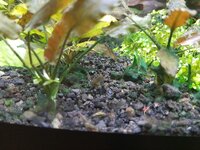Andrew Reynolds
Seedling
Hi,
I have a Juwel Vision 180 aquarium that I've owned for quite a few years. Until recently I have been neglecting it with water changes only every 6 weeks or so, but the fish seemed happy and the small cryps and giant Vallisneria was growing alright with just the standard Juwel T5 lights. There was a bit of blck beard algae.
Then the lighting unit failed so I ordered a replacement which has two 19w LED lights, one 6500K and the other 9000k.
When the new light arrived I decided I was going to revive the tank and get it looking good again. I gave it a good clean. Set up the CO2 system that I had not used for years, bought new plants, put in 6 small siamese algae eaters to fight the BBA and also bought 10 Rummy Nose Tetras. The total fish count now is 6 congo tetra, 10 Rummy Nose Tetra, 4 Serpae Tetra, 2 Coolie Loaches and 1 Rainbow Garra and 1 ammo shrimp.
I have two Hydor Nano 900 power heads to increase circulation as the internal Juwel filter only cycles the tank 4 times an hour.
The substrate has been in for years and is some sort of volcanic type that was recommended for plant growth at the time. I have used easy life root sticks near the roots of Amazon Swords and a big Cryp. I have used Tropica Premium Nutrition as a liquid fertiliser which has instructions to does weekly but I know a lot of people dose liquid fertiliser daily. I have also been using Seachem Flourish Excel daily (3ml) to help combat the BBA. I have had the CO2 & lights on 8hrs a day with the CO2 starting and stopping an hour before the lights. I have just reduced this to 6 hrs to see if it will help.
The new setup has only been in place for about 10 days. The tank is looking good and I can see oxygen bubbles rising from the plants, but I am getting cyanobacteria on the gravel and foreground plant at the front of the tank. I have been trying to remove this manually every day but it comes back each day.
My question is will the plants eventually out compete the cyanobacteria so that it disappears if I do nothing but normal weekly water changes, or should I do a 3 day black out or treat with something like Easy Life Blue Exit. I have 3% Hydrogen Peroxide but am nervous of it killing my filter material?
Also, I am wondering about reducing my quantity of fish by getting rid of the Congo Tetra.
All opinions gladly received.
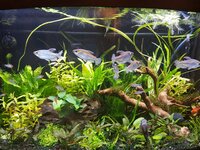
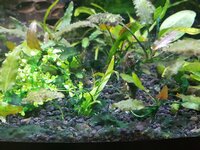
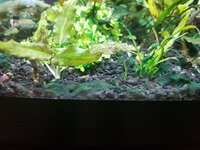
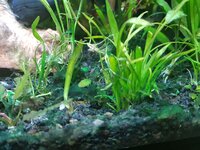
I have a Juwel Vision 180 aquarium that I've owned for quite a few years. Until recently I have been neglecting it with water changes only every 6 weeks or so, but the fish seemed happy and the small cryps and giant Vallisneria was growing alright with just the standard Juwel T5 lights. There was a bit of blck beard algae.
Then the lighting unit failed so I ordered a replacement which has two 19w LED lights, one 6500K and the other 9000k.
When the new light arrived I decided I was going to revive the tank and get it looking good again. I gave it a good clean. Set up the CO2 system that I had not used for years, bought new plants, put in 6 small siamese algae eaters to fight the BBA and also bought 10 Rummy Nose Tetras. The total fish count now is 6 congo tetra, 10 Rummy Nose Tetra, 4 Serpae Tetra, 2 Coolie Loaches and 1 Rainbow Garra and 1 ammo shrimp.
I have two Hydor Nano 900 power heads to increase circulation as the internal Juwel filter only cycles the tank 4 times an hour.
The substrate has been in for years and is some sort of volcanic type that was recommended for plant growth at the time. I have used easy life root sticks near the roots of Amazon Swords and a big Cryp. I have used Tropica Premium Nutrition as a liquid fertiliser which has instructions to does weekly but I know a lot of people dose liquid fertiliser daily. I have also been using Seachem Flourish Excel daily (3ml) to help combat the BBA. I have had the CO2 & lights on 8hrs a day with the CO2 starting and stopping an hour before the lights. I have just reduced this to 6 hrs to see if it will help.
The new setup has only been in place for about 10 days. The tank is looking good and I can see oxygen bubbles rising from the plants, but I am getting cyanobacteria on the gravel and foreground plant at the front of the tank. I have been trying to remove this manually every day but it comes back each day.
My question is will the plants eventually out compete the cyanobacteria so that it disappears if I do nothing but normal weekly water changes, or should I do a 3 day black out or treat with something like Easy Life Blue Exit. I have 3% Hydrogen Peroxide but am nervous of it killing my filter material?
Also, I am wondering about reducing my quantity of fish by getting rid of the Congo Tetra.
All opinions gladly received.






